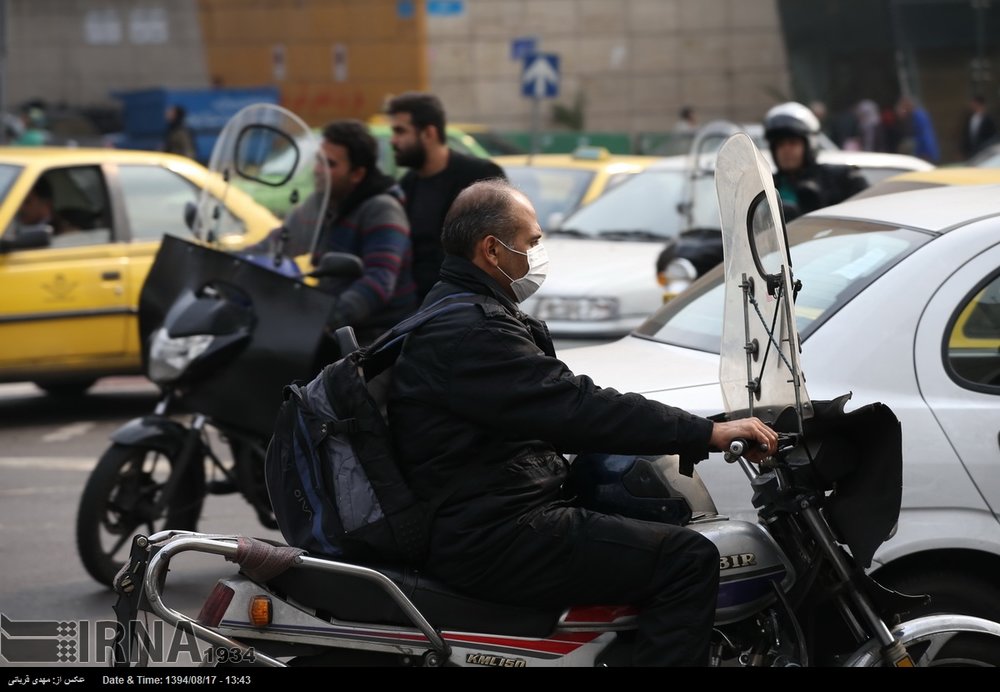Villain in Tehran air pollution: Carbureted motorcycles to go into production again?

TEHRAN — While the production of carbureted-engine motorcycles was halted in Iran as of late September 2016 renewed speculation is mounting that the highly polluting vehicles might go into production again.
The Tehran motorcycle fleet consists mostly of carburetor-equipped motorcycles which are typically less fuel efficient and emit more emissions compared to newer, fuel injection technology.
In order to tackle the problem, the national working group for air pollution mitigation, affiliated to the Department of Environment (DOE), made a proposal to bring production of the pollutant carbureted-engine motorcycles to halt some two years ago. The cabinet of ministers approved the proposal in June 22, 2016 which went into effect as of September 2016. While there are still about 1 million motorcycles in the capital the law was hoped to cease the production of the polluting models and encourage fuel injection technology and manufacture of electric motorcycles.
However, in a letter written jointly by the ministers of interior and industry, mining, and trade the two officials have appealed to the First Vice President Es’haq Jahangiri to reconsider the carbureted motorcycles production halt and allow issuance of license plates for 10,000 motorcycles, ISNA reported on Tuesday.
Interior Minister Abdolreza Rahmani-Fazli, and Industry, Mining and Trade Minister Mohammad Shariatmadari have claimed that some manufacturers were not aware of the production halt and that not issuing license plate for the 1,000 motorcycles may have some adverse social and economic consequences. They have further urged the cabinet to approve the issuance of license plate for the already-manufactured motorcycles.
This is while after the production halt some 400,000 carbureted-engine motorcycles which have been manufactured prior to the approval of the proposal were licensed.
Issa Kalantari, DOE chief has told ISNA that the Department is adamantly opposed to issuing license for new carbureted motorcycles, however, he regretted the fact that if the cabinet decides to grant the permission for issuing license plate for the motorcycles the DOE is almost powerless to do anything about it.
Unfortunately this is not the first time the Industry, Mining and Trade Ministry is demanding the issuance of license plate for carbureted-motorcycles. Mehdi Dehqan-Azad, an official with National Standard Organization, has said that last year, adding an article to the proposal, the Ministry has issued license plate for some 740,000 carbureted-engine motorcycles.
Deputy environment chief Masoud Tajrishi also said that during a cabinet meeting held on Sunday only three organizations opposed the issuance of license plate for 10,000 carbureted motorcycles and the rest unanimously agreed halting the production for good would jeopardize employment.
That the manufacturers object the production halt by claiming that they were not properly informed is not acceptable, Tajrishi said. Using economic problems as an excuse to undermine the public health is “upsetting”, he stated, adding that this is a test to see which one “we” prioritize: the current and next generations’ health or short-term advantages.
“Voting in favor of issuing license for more carburetor motorcycles means that we have failed to well-inform the officials about the environmental catastrophes and this is why many think that ignoring such proposals is not violation of the law,” he lamented.
Vahid Hosseini head of the national working group for air pollution mitigation has also objected the issuance of license plate for carbureted motorcycles in a letter published on the working group official website.
Now, after two years from the approval of the proposal to halt the production of carbureted motorcycles, there are no reasons for making any exceptions, Hosseini wrote. “Doesn’t issuance of license plate for carbureted motorcycles mean that all proposals approved by the cabinet can be broken? And doesn’t it infringe on the rights of the manufacturers who have complied with the production halt and started to adopt fuel injection technology?”
Issuance of license plate for carbureted motorcycles is an anti-environmental move and brings disappointment, Hosseini concluded.
According to a report published by World Bank in April 2018 there are about 4.24 million vehicles in Tehran. With a total fleet of 3.37 million cars are the largest vehicle types. The second largest category, in terms of sheer numbers, are motorcycles, amounting to a total of 0.76 million, or 18 percent of total vehicles. The smallest category is heavy-duty vehicles, with a total of 0.1 million vehicles, or about 2 percent of total vehicles in the streets of Tehran.
Cars only contribute about 3 percent of the city’s mobile PM pollution. Motorcycles being the most pollution intensive vehicle per passenger, contribute to about 12 percent of the total mobile PM emissions and heavy-duty vehicles contribute about 85 percent to mobile PM emissions.
Therefore, motorcycles are the second largest contributor to PM, even before cars which greatly outnumber them. One of the main reasons behind their high contribution to emissions is that a large part of the fuel consumed in motorcycles burns incompletely.
MQ/MG
Leave a Comment